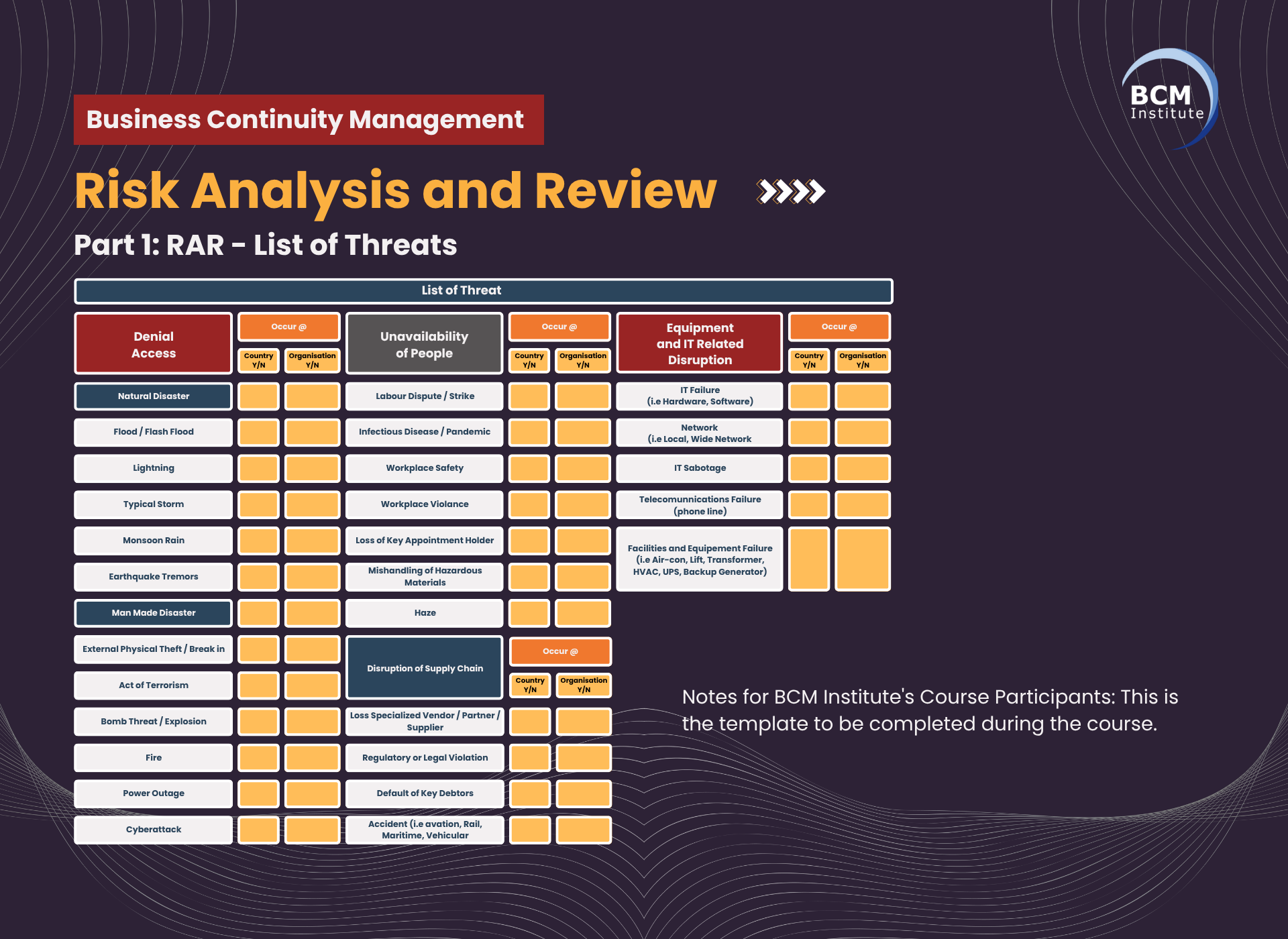
Part 1: RAR – List of Threats for the Pavilion Kuala Lumpur
Introduction
![[BCM] [GEN] [E3] [RAR] [T1] List of Threats](https://blog.bcm-institute.org/hs-fs/hubfs/Generic%20Morepost%20for%20Companies/Updated%20Generic%20BCM%20eBook%20Morepost/BCM%20GEN%20E3/%5BBCM%5D%20%5BGEN%5D%20%5BE3%5D%20%5BRAR%5D%20%5BT1%5D%20List%20of%20Threats.png?width=193&height=169&name=%5BBCM%5D%20%5BGEN%5D%20%5BE3%5D%20%5BRAR%5D%20%5BT1%5D%20List%20of%20Threats.png) The Pavilion Kuala Lumpur, a premier retail and lifestyle destination located in the Bukit Bintang district, is one of Malaysia’s most iconic shopping malls. With its high visitor volume, extensive retail mix, and integration with office towers, residences, and hotels, the mall’s business continuity depends on the ability to anticipate and mitigate a wide range of threats.
The Pavilion Kuala Lumpur, a premier retail and lifestyle destination located in the Bukit Bintang district, is one of Malaysia’s most iconic shopping malls. With its high visitor volume, extensive retail mix, and integration with office towers, residences, and hotels, the mall’s business continuity depends on the ability to anticipate and mitigate a wide range of threats.
In accordance with the Risk Analysis and Review (RAR) phase of the ISO 22301 Business Continuity Management System (BCMS) framework, this section identifies potential threats to Pavilion Kuala Lumpur’s operations.
The analysis considers both country-level and organisation-level perspectives, ensuring that all foreseeable natural, technological, and human-induced risks are addressed.
The following table categorises and describes threats under five major categories:
- Denial of Access – Natural Disaster
- Denial of Access – Man-made Disaster
- Unavailability of People
- Disruption to the Supply Chain
- Equipment and IT-Related Disruption
Table: List of Threats Affecting Pavilion Kuala Lumpur
|
Category of Threats |
Types of Threats |
Description of Threats |
Country Level |
Organisation Level |
|
Denial of Access – Natural Disaster |
Flood |
Heavy rainfall and inadequate urban drainage may cause flash floods in the Bukit Bintang area, affecting mall accessibility and basement facilities. |
Frequent urban flash floods in Kuala Lumpur due to monsoon rains. |
Disruption to the basement car park, loading bays, and access roads. |
|
|
Severe Storms / Strong Winds |
Thunderstorms with high winds may damage exterior structures, signage, and glass façades. |
Seasonal thunderstorms are common during monsoon periods. |
Damage to outdoor signage, entrances, and temporary event setups. |
|
|
Haze / Air Pollution |
Transboundary haze from regional forest fires affects air quality and visitor traffic. |
Recurring haze episodes in Malaysia from forest fires in neighbouring countries. |
Reduction in visitor footfall and indoor air quality issues. |
|
|
Earthquake (Tremor Impact) |
Although Malaysia is not on a major fault line, tremors from regional quakes can cause building evacuations. |
Minor tremors from regional seismic activity. |
Temporary evacuation leading to business disruption. |
|
Denial of Access – Man-made Disaster |
Fire |
Fire outbreaks in retail outlets, food courts, or mechanical areas may cause extensive damage and evacuation. |
National concern for fire safety in high-density complexes. |
Disruption of retail operations and activation of fire response and recovery plans. |
|
|
Terrorism / Bomb Threats |
Potential target due to its status as a major public and tourist location. |
Ongoing national vigilance against terrorism. |
Evacuation, lockdown, and reputational impact on mall safety. |
|
|
Civil Unrest / Protest |
Public gatherings in Bukit Bintang could escalate, causing road closures and safety risks. |
Periodic political or social demonstrations in Kuala Lumpur. |
Restricted access for tenants, staff, and shoppers. |
|
|
Utility Failure (Power/Water/Gas) |
Failure in public utility systems leading to mall closure or service interruptions. |
Nationwide instability in electricity or water supply during peak demand. |
Operational disruption of lighting, elevators, and air-conditioning systems. |
|
|
Structural Failure |
Building or infrastructure failure due to age, poor maintenance, or overload. |
High-rise building compliance under the National Building Code. |
Closure of affected sections and repair costs. |
|
Unavailability of People |
Staff Absenteeism (Illness / Pandemic) |
Outbreaks like COVID-19 may reduce manpower for maintenance, security, and retail operations. |
Nationwide health emergency or movement restrictions. |
Reduced workforce affecting mall and tenant operations. |
|
|
Transport Disruption |
Inability of staff or customers to reach the mall due to transportation failure or strikes. |
Public transport or Grab driver strikes/road blockages. |
Limited staffing and reduced visitor numbers. |
|
|
Security Personnel Shortage |
Outsourced guards are unavailable due to an agency strike or illness. |
Labour market disruptions. |
Increased vulnerability to theft and crowd control challenges. |
|
Disruption to the Supply Chain |
Supplier Delivery Delay |
Disruption in the delivery of essential goods and maintenance supplies. |
Port congestion, customs delays, or interstate restrictions. |
Shortage of maintenance materials and store inventory. |
|
|
Tenant Supply Chain Failure |
Retail tenants are unable to source products from international suppliers. |
Regional supply chain breakdowns (e.g., shipping delays, currency fluctuation). |
Loss of sales and customer dissatisfaction. |
|
|
Utility Supply Chain Failure |
Delays in obtaining spare parts or technical maintenance services. |
Limited availability of critical spare parts in Malaysia. |
Extended downtime for key building systems. |
|
Equipment and IT-Related Disruption |
IT System Failure |
Malfunction of tenant POS systems or the mall’s digital infrastructure (CCTV, access control). |
National reliance on digital systems and cybersecurity vulnerabilities. |
Transaction disruptions, reduced security monitoring. |
|
|
Cyberattack / Data Breach |
Hacking or ransomware targeting the mall’s operational or marketing systems. |
Rising cybercrime incidents in Malaysia. |
Compromised tenant data, loss of reputation, potential legal impact. |
|
|
Mechanical System Breakdown |
Failure of elevators, escalators, chillers, or HVAC systems. |
Wear and tear from continuous operation. |
Reduced comfort, safety, and accessibility for shoppers and tenants. |
|
|
Telecommunication Failure |
Disruption to the internet or mobile network connectivity within the mall. |
Telco network maintenance or system outage. |
Disruption to digital payment systems and communication channels. |
Summing Up …
The Pavilion Kuala Lumpur operates within a dynamic urban environment where natural, technological, and human-related risks coexist. The identification of these threats forms the foundation of a comprehensive Risk Analysis and Review (RAR) process under ISO 22301.
By recognising these potential disruptions at both national and organisational levels, Pavilion Kuala Lumpur can prioritise risk mitigation, strengthen emergency response measures, and enhance its overall business continuity and resilience.
The next step in the BCM process will involve assessing the likelihood and impact of each identified threat and developing corresponding business continuity strategies to minimise disruption to critical business functions.
Implementing BCM: Pavilion Kuala Lumpur — A Case in Retail Resilience |
||||||
| eBook 3: Starting Your BCM Implementation |
||||||
| MBCO | P&S | RAR T1 | RAR T2 | RAR T3 | BCS T1 | CBF |
More Information About Business Continuity Management Courses
To learn more about the course and schedule, click the buttons below for the BCM-300 Business Continuity Management Implementer [BCM-3] and the BCM-5000 Business Continuity Management Expert Implementer [BCM-5].







![Register [BL-B-3]*](https://no-cache.hubspot.com/cta/default/3893111/ac6cf073-4cdd-4541-91ed-889f731d5076.png)



![FAQ [BL-B-3]](https://no-cache.hubspot.com/cta/default/3893111/b3824ba1-7aa1-4eb6-bef8-94f57121c5ae.png)
![Email to Sales Team [BCM Institute]](https://no-cache.hubspot.com/cta/default/3893111/3c53daeb-2836-4843-b0e0-645baee2ab9e.png)





